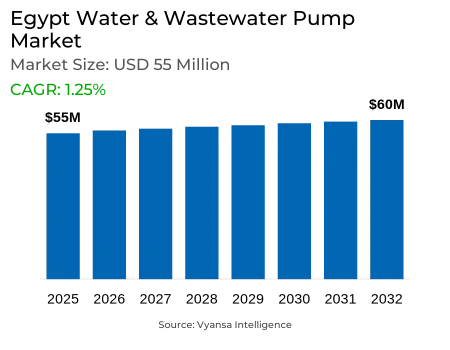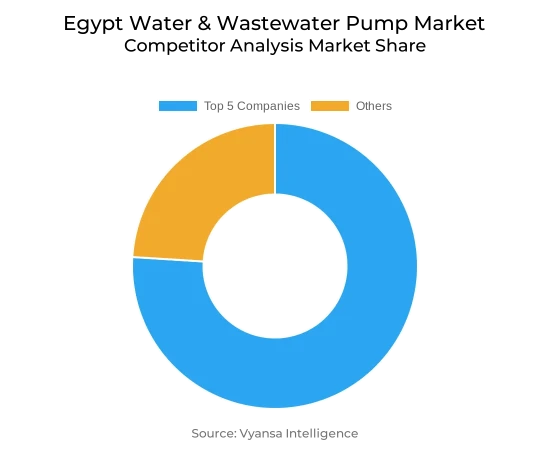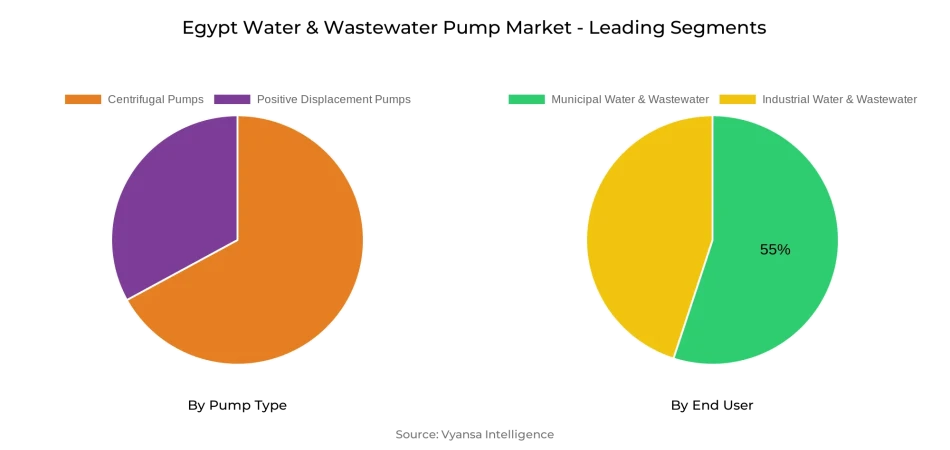
Egypt Water & Wastewater Pump Market Report: Trends, Growth and Forecast (2026-2032)
By Pump Type (Centrifugal Pumps (End Suction, Split Case, Vertical (Turbine, Axial Pump, Mixed Flow Pump), Submersible Pump), Positive Displacement Pumps (Progressing Cavity, Diaphragm, Gear Pump, Others)), By Application (Water, Wastewater), By End User (Industrial Water & Wastewater, Municipal Water & Wastewater)
- Energy & Power
- Oct 2025
- VI0478
- 125
-




Egypt Water & Wastewater Pump Market Statistics and Insights, 2026
- Market Size Statistics
- Water & Wastewater Pump in Egypt is estimated at $ 55 Million.
- The market size is expected to grow to $ 60 Million by 2032.
- Market to register a CAGR of around 1.25% during 2026-32.
- Pump Type Segment
- Centrifugal Pumps continues to dominate the market.
- Competition
- More than 10 companies are actively engaged in producing Water & Wastewater Pump in Egypt.
- Top 5 companies acquired the maximum share of the market.
- ITT, IDEX, Dover, Flowserve, Sulzer AG etc., are few of the top companies.
- End User
- Municipal Water & Wastewater grabbed 55% of the market.
Egypt Water & Wastewater Pump Market Outlook
The Egypt Water & Wastewater Pump Market is worth USD 55 million in 2025 and is estimated to reach USD 60 million by 2032, driven by constant infrastructure renewal and increasing demand for assured water supply. Cairo, especially, is replacing aged pumps to offset frequent service interruptions, since over 40% of Egypt's water pipes are over 30 years old. New pump installations improve flow efficiency as much as 12%, enabling utilities to keep water pressure stable throughout populous areas. Meanwhile, more stringent discharge requirements compel the improvement of wastewater facilities, where state-of-the-art pump systems allow for standardized treatment cycles and lower the risk of environmental damage.
The market is also challenged by power outages, 3.5 a month on average in major governorates, which halt pump activities and pose risks of downtime. Utilities are meeting this by implementing backup generators and redundancies. Coastal aquifers present another challenge, with saline intrusion speeding up corrosion rates by 15% in brackish conditions. To achieve long-term performance, utilities more commonly use corrosion-resistant coatings and durable pump materials.
On the technology front, Egypt is progressing in the direction of digital monitoring systems. SCADA integration and IoT-enabled sensors make possible real-time monitoring of vibration and flow rates, reducing maintenance response time by 25% and lowering energy bills up to 10%. Pumping scheduling through data-driven means during off-peak periods further reduces the cost of electricity and saves around 8% per year. These intelligent solutions enable centralized visibiliy across plants, enhancing decision making and operational efficiency.
By pump type, centrifugal pumps are most prevalent in the market as a testament to their affordability and versatility. Positive displacement pumps are still restricted to specialty applications such as chemical dosing. Among end customers, municipal water and wastewater utilities are top with 55% share on account of high-volume supply and treatment requirements, and industrial water and wastewater is the most rapidly expanding segment, growing at a CAGR of 3.2% as industries invest in specialized pumping systems for compliance and efficiency.

Egypt Water & Wastewater Pump Market Growth Driver
Accelerating Infrastructure Renewal Across Egypt’s Aging Water Distribution and Treatment Networks
Cairo makes massive pump replacements to solve degraded pipelines and recurring service disruptions. More than 40% of Egypt's water supply network is over 30 years old, causing pressure loss and leakages. New pump installations optimize flow efficiency by up to 12%, guaranteeing reliable supply through densely populated areas.
Urban growth forces governments to modernize wastewater treatment plants. Discharge without treatment now impacts 28% of the Nile Delta's rivers, forcing tighter discharge regulations. High-tech pump systems facilitate compliance by ensuring regular cycles of treatment, minimizing the risks to the environment and protecting public health.
Egypt Water & Wastewater Pump Market Challenge
Ensuring Continuous Pump Operation Amidst Frequent Power Outages and Saline Intrusion
Regular power outages complicate round-the-clock pump operation, with Egypt experiencing 3.5 power disruptions per month across main governorates. Unplanned downtime threatens service disruptions and equipment loss, necessitating backup generators and pump redundancies.
Saline intrusion in the coastal aquifers increases maintenance requirements. Pumps used in brackish conditions incur corrosion rates 15% greater than in freshwater use, with a consequence of more frequent overhaul. Strong material selection and corrosion-resistant coatings become crucial to maintain long-term performance.
Egypt Water & Wastewater Pump Market Trend
Adoption of IoT-Enabled Smart Control Systems for Pump Performance Optimization
Digital monitoring systems become more popular as utilities want real-time data on pump performance. Remote sensors monitor vibration and flow rates, reducing maintenance response times by 25% and minimizing emergency repairs. IoT-capable controls also minimize energy consumption, reducing pump station electricity bills by 10% through adaptive speed control.
Data analytics uncover patterns of demand, allowing utilities to schedule pumping after business hours and conserve as much as 8% on yearly energy use. Smart dashboards consolidate SCADA inputs, providing a centralized view across multiple treatment plants and reducing operational decision-making burdens.
Egypt Water & Wastewater Pump Market Opportunity
Expanding Decentralized Treated Effluent Reuse Projects to Address Water Scarcity
Increased water shortage spurs investment in the reuse of treated effluent. Egypt is recycling 2.5 billion m³ of wastewater each year for irrigation purposes and supplies around 10% of irrigation supply (Source: FAO). The customized pump solutions enable pressure boost and distribution across large agricultural areas.
Public-private partnerships spur development of decentralized reuse schemes. Peri-urban farm supply is supported by small pump stations, lowering conveyance losses by 18%, improving water-use efficiency. Private sector participation is further encouraged by Ministry of Housing and Utilities incentives, opening up new possibilities for localized water management.
Egypt Water & Wastewater Pump Market Segmentation Analysis

By Pump Type
- Centrifugal Pumps
- Positive Displacement Pumps
The most dominant segment by market share under pump type is Centrifugal Pumps. These are the ones that continue to dominate the market due to their easy design, low maintenance needs, and versatility for a wide variety of flow conditions. More than 80% of water and wastewater pumps newly installed in Egypt are centrifugal types, which is a testament to their ability to withstand varying water quality and pressure requirements.
Positive displacement pumps fulfill specialized applications involving the accurate control of flow, for example, chemical dosing. Their contribution, however, is less than 20% due to greater capital and maintenance expenses. While cost-efficient performance continues to be utilities' main concern, centrifugal technology maintains its dominance.
By End User
- Industrial Water & Wastewater
- Municipal Water & Wastewater
The most dominant market share under end user is Municipal Water & Wastewater, representing 55% of all pump installations. Urban supply and treatment operations are serviced by large-scale pump stations, for which municipal utilities have a constant need.
The Industrial Water & Wastewater segment grows at the highest rate of 3.2% CAGR. Factory operations such as petrochemicals and food processing invest in pumps with special capabilities to deal with high-volume flow and corrosive discharges. Industry's emphasis on in-plant water management and regulatory compliance accounts for this growth.
Top Companies in Egypt Water & Wastewater Pump Market
The top companies operating in the market include ITT, IDEX, Dover, Flowserve, Sulzer AG, KSB, Xylem, Grundfos, Ebara, SPX Flow, etc., are the top players operating in the Egypt Water & Wastewater Pump Market.
Frequently Asked Questions
Related Report
1. Market Segmentation
1.1. Research Scope
1.2. Research Methodology
1.3. Definitions and Assumptions
2. Executive Summary
3. Egypt Water & Wastewater Pump Market Policies, Regulations, and Standards
4. Egypt Water & Wastewater Pump Market Dynamics
4.1. Growth Factors
4.2. Challenges
4.3. Trends
4.4. Opportunities
5. Egypt Water & Wastewater Pump Market Statistics, 2022-2032F
5.1. Market Size & Growth Outlook
5.1.1.By Revenues in US$ Million
5.2. Market Segmentation & Growth Outlook
5.2.1.By Pump Type
5.2.1.1. Centrifugal Pumps- Market Insights and Forecast 2022-2032, USD Million
5.2.1.1.1. End Suction- Market Insights and Forecast 2022-2032, USD Million
5.2.1.1.2. Split Case- Market Insights and Forecast 2022-2032, USD Million
5.2.1.1.3. Vertical- Market Insights and Forecast 2022-2032, USD Million
5.2.1.1.3.1. Turbine- Market Insights and Forecast 2022-2032, USD Million
5.2.1.1.3.2. Axial Pump- Market Insights and Forecast 2022-2032, USD Million
5.2.1.1.3.3. Mixed Flow Pump- Market Insights and Forecast 2022-2032, USD Million
5.2.1.1.4. Submersible Pump- Market Insights and Forecast 2022-2032, USD Million
5.2.1.2. Positive Displacement Pumps- Market Insights and Forecast 2022-2032, USD Million
5.2.1.2.1. Progressing Cavity- Market Insights and Forecast 2022-2032, USD Million
5.2.1.2.2. Diaphragm- Market Insights and Forecast 2022-2032, USD Million
5.2.1.2.3. Gear Pump- Market Insights and Forecast 2022-2032, USD Million
5.2.1.2.4. Others- Market Insights and Forecast 2022-2032, USD Million
5.2.2.By Application
5.2.2.1. Water- Market Insights and Forecast 2022-2032, USD Million
5.2.2.2. Wastewater- Market Insights and Forecast 2022-2032, USD Million
5.2.3.By End User
5.2.3.1. Industrial Water & Wastewater- Market Insights and Forecast 2022-2032, USD Million
5.2.3.2. Municipal Water & Wastewater- Market Insights and Forecast 2022-2032, USD Million
5.2.4.By Competitors
5.2.4.1. Competition Characteristics
5.2.4.2. Market Share & Analysis
6. Egypt Centrifugal Water & Wastewater Pump Market Statistics, 2020-2030F
6.1. Market Size & Growth Outlook
6.1.1.By Revenues in US$ Million
6.2. Market Segmentation & Growth Outlook
6.2.1.By Pump Type- Market Insights and Forecast 2022-2032, USD Million
6.2.2.By Application- Market Insights and Forecast 2022-2032, USD Million
6.2.3.By End User- Market Insights and Forecast 2022-2032, USD Million
7. Egypt Positive Displacement Water & Wastewater Pump Market Statistics, 2020-2030F
7.1. Market Size & Growth Outlook
7.1.1.By Revenues in US$ Million
7.2. Market Segmentation & Growth Outlook
7.2.1.By Pump Type- Market Insights and Forecast 2022-2032, USD Million
7.2.2.By Application- Market Insights and Forecast 2022-2032, USD Million
7.2.3.By End User- Market Insights and Forecast 2022-2032, USD Million
8. Competitive Outlook
8.1. Company Profiles
8.1.1.Flowserve Corporation
8.1.1.1. Business Description
8.1.1.2. Product Portfolio
8.1.1.3. Collaborations & Alliances
8.1.1.4. Recent Developments
8.1.1.5. Financial Details
8.1.1.6. Others
8.1.2.Ebara Corporation
8.1.2.1. Business Description
8.1.2.2. Product Portfolio
8.1.2.3. Collaborations & Alliances
8.1.2.4. Recent Developments
8.1.2.5. Financial Details
8.1.2.6. Others
8.1.3.WILO SE
8.1.3.1. Business Description
8.1.3.2. Product Portfolio
8.1.3.3. Collaborations & Alliances
8.1.3.4. Recent Developments
8.1.3.5. Financial Details
8.1.3.6. Others
8.1.4.Sulzer Limited
8.1.4.1. Business Description
8.1.4.2. Product Portfolio
8.1.4.3. Collaborations & Alliances
8.1.4.4. Recent Developments
8.1.4.5. Financial Details
8.1.4.6. Others
8.1.5.Grundfos Holding A/S
8.1.5.1. Business Description
8.1.5.2. Product Portfolio
8.1.5.3. Collaborations & Alliances
8.1.5.4. Recent Developments
8.1.5.5. Financial Details
8.1.5.6. Others
8.1.6.Xylem Inc.
8.1.6.1. Business Description
8.1.6.2. Product Portfolio
8.1.6.3. Collaborations & Alliances
8.1.6.4. Recent Developments
8.1.6.5. Financial Details
8.1.6.6. Others
8.1.7.KSB SE & Co. KGaA
8.1.7.1. Business Description
8.1.7.2. Product Portfolio
8.1.7.3. Collaborations & Alliances
8.1.7.4. Recent Developments
8.1.7.5. Financial Details
8.1.7.6. Others
8.1.8.Kirloskar Brothers Limited (KBL)
8.1.8.1. Business Description
8.1.8.2. Product Portfolio
8.1.8.3. Collaborations & Alliances
8.1.8.4. Recent Developments
8.1.8.5. Financial Details
8.1.8.6. Others
8.1.9.Franklin Electric
8.1.9.1. Business Description
8.1.9.2. Product Portfolio
8.1.9.3. Collaborations & Alliances
8.1.9.4. Recent Developments
8.1.9.5. Financial Details
8.1.9.6. Others
8.1.10. Pentair PLC
8.1.10.1. Business Description
8.1.10.2. Product Portfolio
8.1.10.3. Collaborations & Alliances
8.1.10.4. Recent Developments
8.1.10.5. Financial Details
8.1.10.6. Others
9. Disclaimer
| Segment | Sub-Segment |
|---|---|
| By Pump Type |
|
| By Application |
|
| By End User |
|
Research Methodology
This study followed a structured approach comprising four key phases to assess the size and scope of the electro-oxidation market. The process began with thorough secondary research to collect data on the target market, related markets, and broader industry context. These findings, along with preliminary assumptions and estimates, were then validated through extensive primary research involving industry experts from across the value chain. To calculate the overall market size, both top-down and bottom-up methodologies were employed. Finally, market segmentation and data triangulation techniques were applied to refine and validate segment-level estimations.
Secondary Research
The secondary research phase involved gathering data from a wide range of credible and published sources. This step helped in identifying industry trends, defining market segmentation, and understanding the market landscape and value chain.
Sources consulted during this phase included:
- Company annual reports, investor presentations, and press releases
- Industry white papers and certified publications
- Trade directories and market-recognized databases
- Articles from authoritative authors and reputable journals
- Gold and silver standard websites
Secondary research was critical in mapping out the industry's value chain and monetary flow, identifying key market segments, understanding regional variations, and tracking significant industry developments.
Other key sources:
- Financial disclosures
- Industry associations and trade bodies
- News outlets and business magazines
- Academic journals and research studies
- Paid industry databases
Primary Research
To validate secondary data and gain deeper market insights, primary research was conducted with key stakeholders across both the supply and demand sides of the market.
On the demand side, participants included decision-makers and influencers from end-user industries—such as CIOs, CTOs, and CSOs—who provided first-hand perspectives on market needs, product usage, and future expectations.
On the supply side, interviews were conducted with manufacturers, industry associations, and institutional participants to gather insights into current offerings, product pipelines, and market challenges.
Primary interviews provided critical inputs such as:
- Market size and revenue data
- Product and service breakdowns
- Market forecasts
- Regional and application-specific trends
Stakeholders consulted included:
- Leading OEM and solution providers
- Channel and distribution partners
- End users across various applications
- Independent consultants and industry specialists
Market Size Estimation and Data Triangulation
- Identifying Key Market Participants (Secondary Research)
- Goal: To identify the major players or companies in the target market. This typically involves using publicly available data sources such as industry reports, market research publications, and financial statements of companies.
- Tools: Reports from firms like Gartner, Forrester, Euromonitor, Statista, IBISWorld, and others. Public financial statements, news articles, and press releases from top market players.
- Extracting Earnings of Key Market Participants
- Goal: To estimate the earnings generated from the product or service being analyzed. This step helps in understanding the revenue potential of each market player in a specific geography.
- Methods: Earnings data can be gathered from:
- Publicly available financial reports (for listed companies).
- Interviews and primary data sources from professionals, such as Directors, VPs, SVPs, etc. This is especially useful for understanding more nuanced, internal data that isn't publicly disclosed.
- Annual reports and investor presentations of key players.
- Data Collation and Development of a Relevant Data Model
- Goal: To collate inputs from both primary and secondary sources into a structured, data-driven model for market estimation. This model will incorporate key market KPIs and any independent variables relevant to the market.
- Key KPIs: These could include:
- Market size, growth rate, and demand drivers.
- Industry-specific metrics like market share, average revenue per customer (ARPC), or average deal size.
- External variables, such as economic growth rates, inflation rates, or commodity prices, that could affect the market.
- Data Modeling: Based on this data, the market forecasts are developed for the next 5 years. A combination of trend analysis, scenario modeling, and statistical regression might be used to generate projections.
- Scenario Analysis
- Goal: To test different assumptions and validate how sensitive the market is to changes in key variables (e.g., market demand, regulatory changes, technological disruptions).
- Types of Scenarios:
- Base Case: Based on current assumptions and historical data.
- Best-Case Scenario: Assuming favorable market conditions, regulatory environments, and technological advancements.
- Worst-Case Scenario: Accounting for adverse factors, such as economic downturns, stricter regulations, or unexpected disruptions.
Partnering With Industry Leaders to Drive Growth
Our mission is to deliver intelligence that matters. By combining data, analysis, and industry expertise, we enable organizations to make smarter, faster, and more impactful decisions. Whether it’s a Fortune 500 company or a high-growth startup, businesses trust us to provide clarity in an ever-evolving marketplace.






